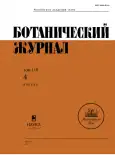GYNOECIUM AND OVULE STRUCTURE IN LYSIMACHIA NUMMULARIA AND L. PUNCTATA (PRIMULACEAE)
- Autores: Shamrov I.I1,2, Anisimova G.M2
-
Afiliações:
- Herzen State Pedagogical University of Russia
- Komarov Botanical Institute of Russian Academy of Sciences
- Edição: Volume 110, Nº 4 (2025)
- Páginas: 364–384
- Seção: COMMUNICATIONS
- URL: https://journal-vniispk.ru/0006-8136/article/view/307713
- DOI: https://doi.org/10.31857/S0006813625040028
- EDN: https://elibrary.ru/GEMUDY
- ID: 307713
Citar
Resumo
Palavras-chave
Sobre autores
I. Shamrov
Herzen State Pedagogical University of Russia; Komarov Botanical Institute of Russian Academy of Sciences
Email: shamrov52@mail.ru
St. Petersburg, Russia
G. Anisimova
Komarov Botanical Institute of Russian Academy of Sciences
Email: galina0353@mail.ru
St. Petersburg, Russia
Bibliografia
- An update of the Angiosperm Phylogeny Group classification for the orders and families of flowering plants: APG II. 2003. – Bot. J. Linn. Soc. 141(4): 399–436. https://doi.org/10.1046/j.1095-8339.2003.t01-1-00158.x
- An update of the Angiosperm Phylogeny Group classification for the orders and families of flowering plants: APG III. 2009. – Bot. J. Linn. Soc. 161(2): 105–121. https://doi.org/10.1111/j.1095-8339.2009.00996.x
- An update of the Angiosperm Phylogeny Group classification for the orders and families of flowering plants: APG IV. 2016. – Bot. J. Linn. Soc. 181(1): 1–20. https://doi.org/10.1111/boj.12385
- Anderberg A.A., Manns U., Källersjö M. 2007. Phylogeny and floral evolution of the Lysimachieae (Ericales, Myrsinaceae): evidence from ndhF sequence data. – Willdenowia. 37: 407–421. https://doi.org/10.3372/wi.37.37202
- [Babro et al.] Бабро А.А., Анисимова Г.М., Шамров И.И. 2007. Репродуктивная биология Rhododendron schlippenbachii и R. luteum (Ericaceae) при интродукции в ботанические сады г. Санкт-Петербурга. – Раст. ресурсы. 43(4): 1–13.
- Chen F.-H., Hu C.-M. 1979. Taxonomic and phytogeographic studies on Chinese species of Lysimachia. – Acta Phytotax. Sin. 17(4): 21–53.
- Christenhusz M.J.M., Fay M.F., Chase M.W. 2017. Primulaceae. – In: Plants of the world: An illustrated encyclopedia of vascular plants. Chicago. 494 p.
- Degtjareva G.V., Sokoloff D.D. 2012. Inflorescence morphology and flower development in Pinguicula alpina and P. vulgaris (Lentibulariaceae: Lamiales): monosymmetric flowers are always lateral and occurrence of early sympetaly. – Org. Divers. Evol. 12(2): 99–111. https://doi.org/10.1007/s13127-012-0074-6
- Douglas G.E. 1936. Studies in the vascular anatomy of the Primulaceae. – Am. J. Bot. 23(3): 199–212.
- Eyde R.H. 1967. The peculiar gynoecial vasculature of Cornaceae and its systematic significance. – Phytomorphology. 17(1–4): 172–182.
- Hao G., Yuan Y.-M., Hu C.-M., Ge X.-J., Zhao N.-X. 2004. Molecular phylogeny of Lysimachia (Myrsinaceae) based on chloroplast trnL–F and nuclear ribosomal ITS sequences. – Mol. Phyl. and Evol. 31(1): 323–339. https://doi.org/10.1016/s1055-7903(03)00286-0
- Hartl D. 1956. Die Beziehungen zwischen den Plazenten der Lentibulariaceen und Scrophulariaceen nebst einem Excurs über Spezialisationsrichtungen der Plazentation. – Beitr. Biol. Pflanzen. 32(3): 471–490.
- Källersjö M., Bergqvist G., Anderberg A.A. 2000. Generic realignment in primuloid families of the Ericales s. l.: a phylogenetic analysis based on DNA sequences from three chloroplast genes and morphology. – Am. J. Bot. 87: 1325–1341.
- [Kamelina] Камелина О.П. 2009. Систематическая эмбриология цветковых растений. Двудольные. Барнаул. 501 c.
- [Karpisonova et al.] Карписонова Р.А., Бочкова И.Ю., Васильева И.В. и др. 2011. Культурная флора травянистых декоративных многолетников средней полосы России: Атлас. М. 432 c.
- Kimura M. 1980. A simple method of estimating evolutionary rate of base substitutions through comparative studies of nucleotide sequences. – J. Mol. Evol. 16: 111–120.
- Leinfellner W. 1951. Die U-formige Plazenta als der Plazentationstypus der Angiospermen. – Österr. Bot. Zeitschr. 98(3): 338–358.
- Liu T.J., Zhang S.Y., Wei L., Yan H.-F., Hao G., Ge X.-J. 2023. Plastome evolution and phylogenomic insights into the evolution of Lysimachia (Primulaceae: Myrsinoideae). – BMC Plant Biol. 23, article 359. https://doi.org/10.1186/s12870-023-04363-z
- Mabberley D.J. 2009. Mabberley’s plant-book: a portable dictionary of plants, their classification and uses. Cambridge. 920 p.
- [Mametyeva] Маметьева Т.Б. 1983a. Семейство Myrsinaceae. – В кн.: Сравнительная эмбриология цветковых растений. Phytolaccaceae–Thymelaeaceae. Л. С. 236–239.
- [Mametyeva] Маметьева Т.Б. 1983b. Семейство Theophrastaceae. – В кн.: Сравнительная эмбриология цветковых растений. Phytolaccaceae–Thymelaeaceae. Л. С. 239–241.
- [Mametyeva] Маметьева Т.Б. 1983c. Семейство Primulaceae. – В кн.: Сравнительная эмбриология цветковых растений. Phytolaccaceae–Thymelaeaceae. Л. С. 241–243.
- Martins L., Oberprieler C., Hellwig F.H. 2003. A phylogenetic analysis of Primulaceae s. l. based on internal transcribed spacer (ITS) DNA sequence data. – Plant Syst. Evol. 237(3): 75–85. https://doi.org/10.1007/s00606-002-0258-1
- [Nemirovich-Danchenko] Немирович-Данченко Е.Н. 1992a. Семейство Theophrastaceae. – В кн.: Сравнительная анатомия семян. Т. 4. Двудольные. Dilleniidae. СПб. С. 54–57.
- [Nemirovich-Danchenko] Немирович-Данченко Е.Н. 1992b. Семейство Myrsinaceae. – В кн.: Сравнительная анатомия семян. Т. 4. Двудольные. Dilleniidae. СПб. С. 58–65.
- [Nemirovich-Danchenko] Немирович-Данченко Е.Н. 1992c. Семейство Primulaceae. – В кн.: Сравнительная анатомия семян. Т. 4. Двудольные. Dilleniidae. СПб. С. 65–70.
- [Nemirovich-Danchenko] Немирович-Данченко Е.Н. 1992d. Семейство Aegicerataceae. – В кн.: Сравнительная анатомия семян. Т. 4. Двудольные. Dilleniidae. СПб. С. 71–77.
- [Pausheva] Паушева З.П. 1974. Практикум по цитологии растений. М. 288 с.
- [Pushkareva et al.] Пушкарева Л.А., Виноградова Г.Ю., Титова Г.Е. 2018. Репродуктивная биология Pinguicula vulgaris (Lentibulariaceae) в Ленинградской области. – Бот. журн. 103(12): 1501–1513.
- [Shamrov] Шамров И.И. 2010. Особенности формирования синкарпного гинецея у некоторых однодольных растений. – Бот. журн. 98(5): 568–595.
- [Shamrov] Шамров И.И. 2013. Еще раз о типах гинецея покрытосеменных растений. – Бот. журн. 98(5): 568–595.
- Shamrov I.I. 2018. Diversity and typification of ovules in flowering plants. – Wulfenia. 25: 81–109.
- Shamrov I.I. 2020. Structure and development of coenocarpous gynoecium in angiosperms. – Wulfenia. 27: 145–182.
- [Shamrov et al.] Шамров И.И., Анисимова Г.М., Рущина Е.А. 2024. Строение гинецея и семязачатка у Lysimachia vulgaris (Primulaceae). – Бот. журн. 109(10): 947–976. EDN: OLLYVK. https://doi.org/10.31857/S0006813624100012
- [Shamrov, Kotelnikova] Шамров И.И., Котельникова Н.С. 2011. Особенности формирования гинецея у Coccyganthe flos-cuculi (Caryophyllaceae). – Бот. журн. 96(7): 826–850.
- Troll W. 1957. Praktische Einführung in die Pflanzenmorphologie. Jena. 420 S.
- [Veselova, Timonin] Веселова Т.Д., Тимонин А.К. 2008. Развитие женской генеративной сферы Pleuropetalum darwinii Hook. F. (Caryophyllidae). – Бюл. МОИП. Отд. биол. 113(4): 33–39.
- Veselova T.D., Timonin A.C. 2009. Pleuropetalum Hook. f. is still an anomalous member of Amaranthaceae Juss. An embryological evidence. – Wulfenia. 16: 99–116.
Arquivos suplementares









